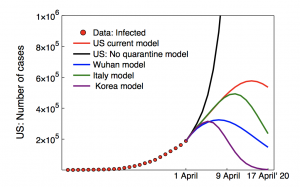Artificial Intelligence
MIT’s AI Makes Predictions About COVID-19

Engineers at MIT have trained an AI capable of making predictions about COVID-19 by looking at social distancing measures, quarantine orders, and government action. The AI predicted that the COVID-19 cases in Italy and the United States could begin to level off by next week, but it depends on social distancing measures. It also predicted that if the U.S. begins to reopen too soon, the outcome could be catastrophic for the nation.
George Barbastathis is an MIT professor of mechanical engineering. He developed the model alongside civil and environmental engineering Ph.D. candidate Raj Dandekar.
“Our model shows that quarantine restrictions are successful in getting the effective reproduction number from larger than one to smaller than one. The [model] is learning what we are calling the ‘quarantine control strength function,'” said George Barbastathis. “That corresponds to the point where we can flatten the curve and start seeing fewer infections.”
Training the AI
Data from January through early March was used to train the AI at MIT, and its predictions for April were consistent with the actual statistics, proving the model to be capable of making accurate predictions.
According to the research paper, analysis was focused on fair main locations: Wuhan, Italy, South Korea, and the United States. It compared the effects of quarantine and isolation measures in each of the countries and how they controlled the virus. The model was capable of learning patterns in the spread of COVID-19.

Image: MIT
Quarantine and Isolation Measures
The results found that the spread of infection was best managed and prevented from exponentially increasing in the countries where quarantine and isolation measures were implemented. The AI also predicted that the United States should experience a “halting of infections” around April 20, but once again, it is dependent on the current social distancing and isolation measures staying in place.
This fits into the pattern of what happened in Singapore. The nation implemented social distancing and quarantine measures that led to a complete flattening of the curve, but it did not last. Once the safety measures were lifted, the virus rushed back into the population and cases of COVID-19 increased once again.
The same thing could happen in the United States depending on what steps are taken.
“This is a really crucial moment of time. If we relax quarantine measures, it could lead to disaster,” said Barbastathis. “If the U.S. were to follow the same policy of relaxing quarantine measures too soon, we have predicted that the consequences would be far more catastrophic.”
The model also predicted that before the rate of infection begins to halt in the United States, cases will reach 600,000.
Another effort led by an international team of researchers relied on human mobility data supplied by Baidu, the Chinese technology company. The findings indicated that control and containment measures were effective, turning growth rates negative in most locations.














